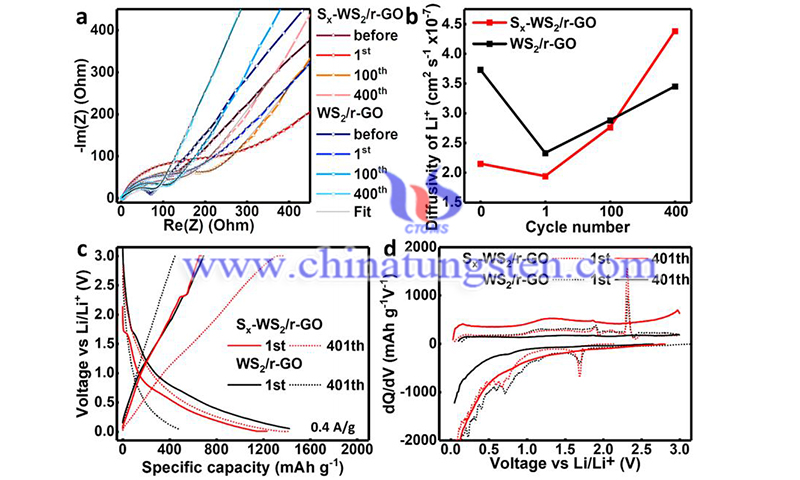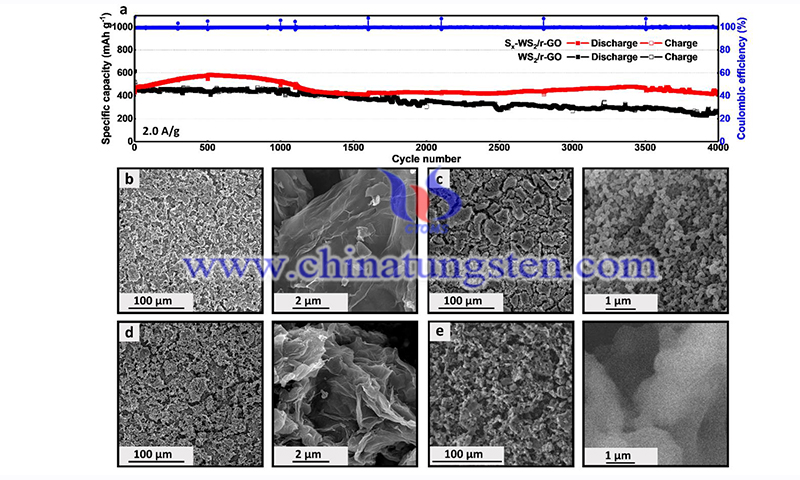Tungsten Disulfide for Electrode Materials of Supercapacitor
- Details
- Category: Tungsten Information
- Published on Monday, 05 September 2022 22:48
Recently, researchers demonstrated a specific capacitance of 398.5 F.g-1 for sheet tungsten disulfide anode materials. However, the performance of these materials remains unsatisfactory. Encouragingly, Nagaraju et al. synthesized WS2 nanoparticles used as supercapacitor electrode materials, which provided a high capacitance value of 1439.5 F.g-1 at a current density of 5 mA.cm-2 and maintained excellent cycling stability of 77.4% after 3000 cycles. This result suggests that WS2 can be considered a promising candidate for supercapacitor electrode materials.
An alternative approach is to design composite structures to improve the conductivity of WS2. Carbon materials are often considered as candidates because of their good electrical conductivity, which can facilitate the fast transport of electrolyte ions and improve the supercapacitor performance of WS2.

(Picture source: Uijin Chang/ ACS Appl. Mater. Interfaces)
For example, Ratha et al. synthesized WS2/RGO hybrids that exhibited improved supercapacitor performance with a specific capacitance of 350 F.g-1 at a scan rate of 2 mV.s-1. The capacitance values of the WS2/ RGO hybrids were 5 and 2.5 times higher than those of the pristine WS2 and RGO sheets. Qiu et al. prepared tungsten disulfide nanosheets on activated carbon fibers, and this nanocomposite composite showed a high capacitance of 600 F.g-1 at a current density of 1 A.g-1 in 1 mol.L-1 KOH.
Tu et al. prepared well-structured WS2/RGO nanosheets as electroactive materials for supercapacitors, and the prepared materials exhibited a high specific capacitance of 2508.07 F.g-1 at a scan rate of 1 mV.s-1. This excellent performance can be attributed to the synergistic effect of the two materials, WS2 nanoladders with high capacitance for redox reaction activity and RGO nanosheets with strong electron transfer capability.
As a two-dimensional material with a layered structure, WS2 nanomaterials have made remarkable progress in the fields of electrocatalysis, photocatalysis, batteries, and supercapacitors due to their tunable electronic band structure and special physicochemical properties. This review focuses on the basic characteristics of WS2 nanomaterials and their current research progress. In brief, WS2 nanomaterials have tunable electronic band structures and valuable optical, electrical, and catalytic properties, which determine their potential applications in energy storage and conversion.
To improve the electrochemical and catalytic performance of WS2 nanomaterials for energy conversion and storage devices, several modification strategies have been employed, including crystalline phase modulation, morphology control, and hybrid structures. So far, some encouraging results have been obtained in practical applications, including electrode materials and photocatalysis, batteries, and supercapacitors.

(Picture source: Uijin Chang/ ACS Appl. Mater. Interfaces)
Article Source: Sun, CB., Zhong, YW., Fu, WJ. et al. Tungsten disulfide nanomaterials for energy conversion and storage. Tungsten 2, 109–133 (2020).
- Tungsten Manufacturer & Supplier, Chinatungsten Online: www.chinatungsten.com
- Tungsten News & Prices of China Tungsten Industry Association: www.ctia.com.cn
- Molybdenum News & Price: news.molybdenum.com.cn
- Tel.: 86 592 5129696; Fax: 86 592 5129797; Email: sales@chinatungsten.com



 sales@chinatungsten.com
sales@chinatungsten.com